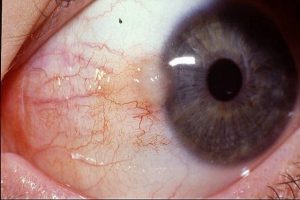The pterygium is also known as surfer’s eye. It is named for a certain type of athlete but the pterygium can affect every single person who spends a lot of time outdoors. This is a growth of the conjunctiva or mucous membrane which covers the white part of the eye over the cornea. We know that the cornea is the clear front which is covering of the eye. It is benign or noncancerous growth which is shaped like a wedge. The pterygium is usually forming on the side which is closest to the nose and grows toward the pupil area. The pterygium usually is not causing problem or it is not requiring treatment. If the pterygium is interfering with your vision, then it can be removed.
Pterygium is often preceded by pinguecula. This is a related non – cancerous condition. It is a yellowish patch or bump on the conjunctiva near the cornea. The thin and moist membrane on the surface of the eye is conjunctiva. This condition can look scary but it is not a cancer. The pterygium can spread slowly during your life or stop after a certain point. There are extreme cases when it can cover your pupil and it can cause vision problems. The pterygium can show up in one eye or both. When the pterygium is affecting the both eyes, then this condition is known as a bilateral pterygium. When you are going out in the sun, then you should wear sunglasses so in this way you can prevent the pterygium. You should wear sunglasses on daily basis. You should choose sunglasses that block 99 – 100% of the both types of UV radiation – UVA (ultraviolet A) and UVB (ultraviolet B). [1]
Pterygium symptoms
This condition is not always causing symptoms. When pterygium causes symptoms, then they are usually mild. The most common symptoms of pterygium are eye irritation, blurred vision and redness. Also when you have pterygium, you can have burning or itching. If the pterygium grows large enough to cover the cornea, then it can interfere with the vision. Also larger or thick pterygium can cause you to feel like you have a foreign object in your eye. When you have pterygium, then you may not be able to continue wearing contact lenses because it is causing discomfort. Also there are some cases when the pterygium can distort the shape of the cornea which is a condition known as astigmatism and the result of this condition can be blurred vision. Here are the most common symptoms of pterygium:
- Blurred vision
- Sensation of a foreign body in the eye
- Feel gritty
- Itching
- Gritty feeling
- Look red
- Burning
If you have some of the above mentioned symptoms, then you need to talk with your doctor. Your doctor can diagnose this condition by looking at part of your eye using a slit lamp which is a special microscope. If your symptoms are mild, then you probably will not need treatment. For more serious cases, your doctor will recommend you eye drops which can help to heal the symptoms of this condition, such as redness, irritation, pain and swelling.
Pterygium causes
The exact cause for pterygium is not known. There is one theory in which is said that too much exposure to UV light can lead to pterygium. [2] Also it happens more often in people who are living in warm climates and people who spend a lot of time outdoors in windy or sunny environments [3]. Those people who live near the equator have increased chances of developing pterygium. The pterygium is most often seen in young people who are between 20 and 40. This condition is more common in men than women [3,4]. Also people whose eyes are exposed to some elements on a regular basis are having increased risk of developing pterygium. These elements are including:
- Wind
- Smoke
- Sand
- Pollen
Complications: There are rare cases when pterygium can lead to severe scarring on the cornea. This condition needs to be treated because if it is left untreated, then it could lead to vision loss. When someone has minor case of pterygium, then the treatment usually is involving ointment or eye drops to treat the inflammation. When someone has more serious case of pterygium, then the treatment is involving surgical removal of the pterygium. [5]
References:
[1] Backes C, Religi A, Moccozet L, et al. Sun exposure to the eyes: predicted UV protection effectiveness of various sunglasses. Journal of Exposure Science & Environmental Epidemiology. 2019;29(6):1.
[2] Behar-Cohen F, Baillet G, de Ayguavives T, et al. Ultraviolet damage to the eye revisited: eye-sun protection factor (E-SPF®), a new ultraviolet protection label for eyewear. Clinical Ophthalmology. 2014;8:87–104.
[3] Anbesse DH, Kassa T, Kefyalew B, et al. Prevalence and associated factors of pterygium among adults living in Gondar city, Northwest Ethiopia. PLoS One. 2017;12(3):e0174450.
[4] Song P, Chang X, Wang M, An L. Variations of pterygium prevalence by age, gender and geographic characteristics in China: A systematic review and meta-analysis. PLoS One. 2017;12(3):e0174587.
[5] Miyamoto R, Sakimoto T, Homma T, et al. A rare case of corneal keloid occurred 30 years after pterygium surgery and 3 years after cataract surgery. American Journal of Ophthalmology Case Reports
2020;20:100901.





